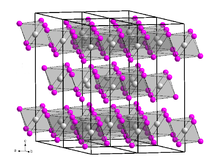This is the current revision of this page, as edited by SeerIeKttom (talk | contribs) at 15:14, 10 December 2024. The present address (URL) is a permanent link to this version.
Revision as of 15:14, 10 December 2024 by SeerIeKttom (talk | contribs)(diff) ← Previous revision | Latest revision (diff) | Newer revision → (diff)
| |
| Names | |
|---|---|
| Other names terbium tribromide | |
| Identifiers | |
| CAS Number | |
| 3D model (JSmol) | |
| ECHA InfoCard | 100.034.932 |
| EC Number |
|
| PubChem CID | |
| CompTox Dashboard (EPA) | |
InChI
| |
SMILES
| |
| Properties | |
| Chemical formula | TbBr3 |
| Molar mass | 398.637 g/mol |
| Appearance | white powder (hexahydrate) |
| Density | 4.62 g/cm |
| Melting point | 827 °C (1,521 °F; 1,100 K) |
| Boiling point | 1,490 °C (2,710 °F; 1,760 K) |
| Solubility in water | soluble |
| Hazards | |
| GHS labelling: | |
| Pictograms | 
|
| Signal word | Warning |
| Hazard statements | H315, H319, H335 |
| Precautionary statements | P261, P264, P271, P280, P302+P352, P304+P340, P305+P351+P338, P312, P321, P332+P313, P337+P313, P362, P403+P233, P405, P501 |
| Except where otherwise noted, data are given for materials in their standard state (at 25 °C , 100 kPa).
| |
Terbium(III) bromide (TbBr3) is a crystalline chemical compound.
Production and properties
Terbiun(III) bromide can be produced by heating terbium metal or terbium(III) oxide with ammonium bromide.
- Tb2O3 + 6 NH4Br → 2 TbBr3 + 6 NH3 + 3 H2O
A solution of terbium(III) bromide can crystallize a hexahydrate. When heating the hexahydrate, it will dehydrate and produce some terbium oxybromide (TbOBr).
Terbium(III) bromide is a white solid that is soluble in water. Its crystal structure is the same as bismuth iodide.
References
- D. Brown, S. Fletcher, D. G. Holah (1968). "The preparation and crystallographic properties of certain lanthanide and actinide tribromides and tribromide hexahydrates". Journal of the Chemical Society A: Inorganic, Physical, Theoretical: 1889–1894. doi:10.1039/j19680001889. ISSN 0022-4944. Retrieved 2020-05-29.
{{cite journal}}: CS1 maint: multiple names: authors list (link) - americanelements.com: Terbium Bromide
- Sigma-Aldrich Co., product no. 466344.
- ^ CRC Handbook of Chemistry and Physics, 87th Edition, S. 4–94
- "Terbium(III) bromide".
- Meyer, Gerd; Dötsch, Siegfried; Staffel, Thomas (January 1987). "The ammonium-bromide route to anhydrous rare earth bromides MBr3". Journal of the Less Common Metals. 127: 155–160. doi:10.1016/0022-5088(87)90372-9. Retrieved 2020-05-29.
- I. Mayer, S. Zolotov (September 1965). "The thermal decomposition of rare earth and yttrium bromide hydrates". Journal of Inorganic and Nuclear Chemistry. 27 (9): 1905–1909. doi:10.1016/0022-1902(65)80042-2. Retrieved 2020-05-29.
- Jean D'Ans, Ellen Lax (1997). Taschenbuch für Chemiker und Physiker. Springer DE. p. 1386. ISBN 354060035-3.
| Terbium compounds | |
|---|---|
| Terbium(III) | |
| Terbium(III,IV) | |
| Terbium(IV) | |
| Salts and covalent derivatives of the bromide ion | ||||||||||||||||||||||||||||||||||||||||||||||||||||||||||||||||||||||||||||||||||||||||||||||||||||||||||||||||||||||||||||||||||||||||||||||||||||||||||||||||||||
|---|---|---|---|---|---|---|---|---|---|---|---|---|---|---|---|---|---|---|---|---|---|---|---|---|---|---|---|---|---|---|---|---|---|---|---|---|---|---|---|---|---|---|---|---|---|---|---|---|---|---|---|---|---|---|---|---|---|---|---|---|---|---|---|---|---|---|---|---|---|---|---|---|---|---|---|---|---|---|---|---|---|---|---|---|---|---|---|---|---|---|---|---|---|---|---|---|---|---|---|---|---|---|---|---|---|---|---|---|---|---|---|---|---|---|---|---|---|---|---|---|---|---|---|---|---|---|---|---|---|---|---|---|---|---|---|---|---|---|---|---|---|---|---|---|---|---|---|---|---|---|---|---|---|---|---|---|---|---|---|---|---|---|---|---|
| ||||||||||||||||||||||||||||||||||||||||||||||||||||||||||||||||||||||||||||||||||||||||||||||||||||||||||||||||||||||||||||||||||||||||||||||||||||||||||||||||||||
This inorganic compound–related article is a stub. You can help Misplaced Pages by expanding it. |